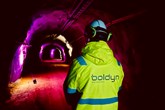Transforming Mining with Agentic AI
Published by Jess Watts,
Editorial Assistant
Global Mining Review,

Technology is reshaping the mining industry. While the industry has not been at the forefront of digitisation, mine operators are starting to see the value of data in driving productivity, safety, and efficiency, while reducing carbon emissions.
In particular, Agentic AI presents exciting potential for miners. From monitoring and scheduling maintenance to enhancing decision making, it is poised to play a transformational role in the future of mining.
Doing more with less
Mine operators currently face the challenge of having to do more with less. They must increase output to meet rising mineral demand while reducing carbon emissions. They must maintain and improve profit margins against a backdrop of rising fuel and other operating costs. They must also enhance efficiency and safety without cutting corners.
Artificial intelligence (AI) can be critical in achieving this. The industry still relies on heavy, diesel-powered equipment, and the complete transition to electric energy remains a long way off.
Operators must become smarter and more efficient with the tools they have. One approach is capturing highly granular data to refine operations and performance – not only improving driving efficiency, but also helping to prevent accidents.
Small changes can have an outsize impact on both productivity and profitability. For example, simply reducing cornering speeds to extend tyre life could save several million dollars annually for the average fleet of forty haul trucks. By optimising loads, thousands of additional tonnes of ore can be moved without increasing the number of journeys. At the Karara Iron Ore project in Western Australia, operators used data science to improve average fill factors by three additional tonnes per load, resulting in an extra 612 000 t of material moved per year.
The next step: Agentic AI
Agentic AI takes this approach to optimising efficiency a step further, with a network of AI agents that act autonomously and cooperatively. Through this system, specific tasks, such as monitoring and scheduling, can be performed independently, with agents triggering actions and coordinating their efforts. Such a system in a mine might look like an ecosystem of AI agents managing maintenance schedules, logistics, inventory, and team alerts. It represents a far more proactive strategy, with AI capable of reasoning and initiating decisions autonomously. Instead of siloed tools and single-function models, these interconnected agents form a cohesive digital decision-making ‘team’.
Short Interval Control (SIC) is still typically tied to an Excel spreadsheet and remains largely reactive. With Agentic AI, if a truck breaks down mid-shift, deviations can be detected instantly, recommendations generated and responses coordinated in real time. Loads can then be rapidly rescheduled and equipment reassigned, rather than discovering the problem at the end of the shift, day, or week.
Risks and obstacles
Despite the potential, mine operators will need to overcome significant barriers to deployment. Upfront investment is one factor, along with the need for human expertise to evaluate and assess solutions. Currently, few off-the-shelf Agentic AI solutions are available to miners, and building a bespoke solution is time-consuming and expensive, requiring further investment in infrastructure and data storage.
Ethical concerns also remain. Striking the right balance of AI autonomy and human oversight will be critical. Most examples of AI experimentation in mining to date focus on back-office or support functions – such as HR or maintenance coordination – rather than core operational control. As agents act with minimal input, it may be unclear who is accountable if and when errors occur. AI hallucinations still happen, responses often vary, and its reasoning must always be verified.
There is also the issue of how data is used and stored, who owns it, and how transparent and auditable AI-driven decisions are. Human involvement and governance will remain essential safeguards.
The future of Agentic AI in mining ultimately depends on the ability to collect high-quality, accessible data. But this is just the foundation. Realising its full potential will also require cultural change, strategic investment and reimagining human-AI collaboration. Miners who successfully adopt this technology can gain improved margins, greater fuel efficiency, and safer operations.
Read the article online at: https://www.globalminingreview.com/exploration-development/13062025/transforming-mining-with-agentic-ai/
You might also like
Private networks, a myth or a solution to digital transformation in mining?
Mines pose extreme connectivity challenges. Jaakko Kuukka, Country Manager Nordics, Boldyn Networks, explains that dedicated 4G and 5G private networks are essential to meet those rising demand and power the industry’s future.


